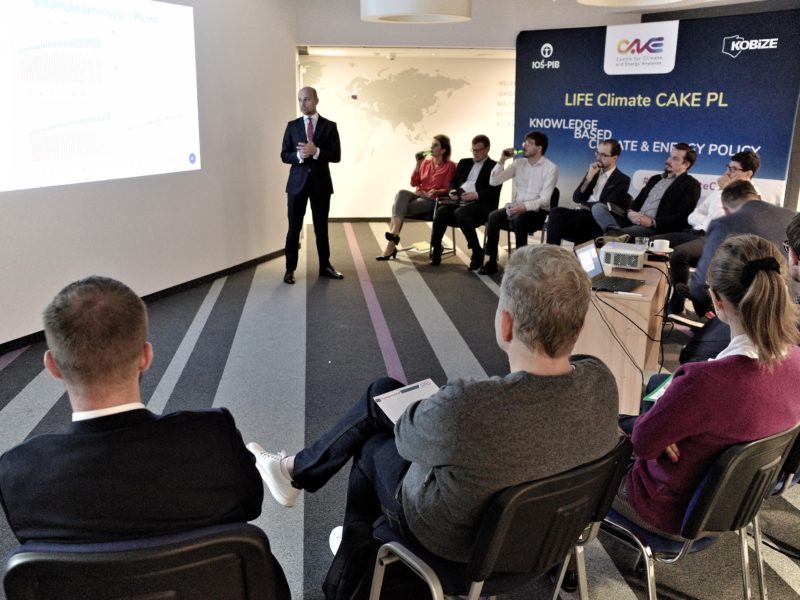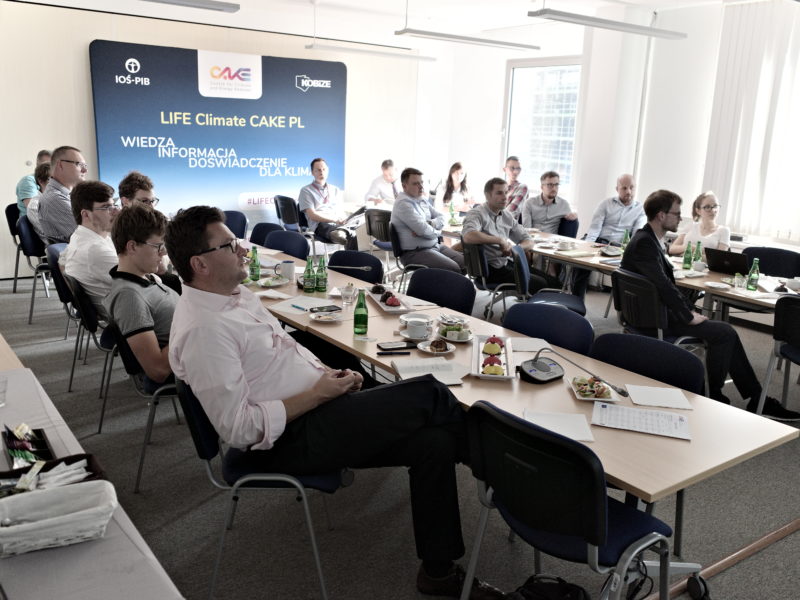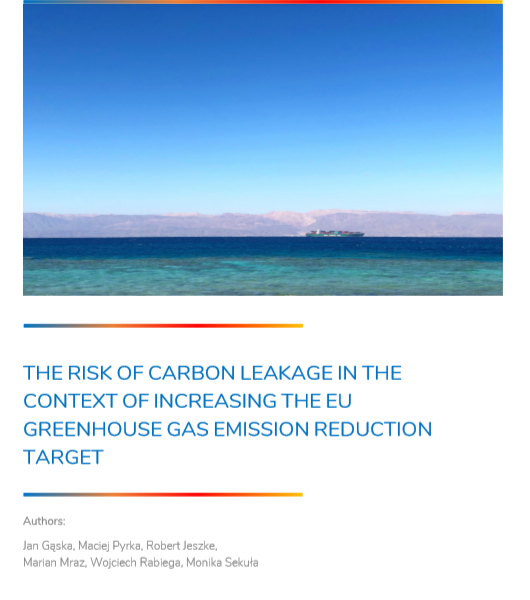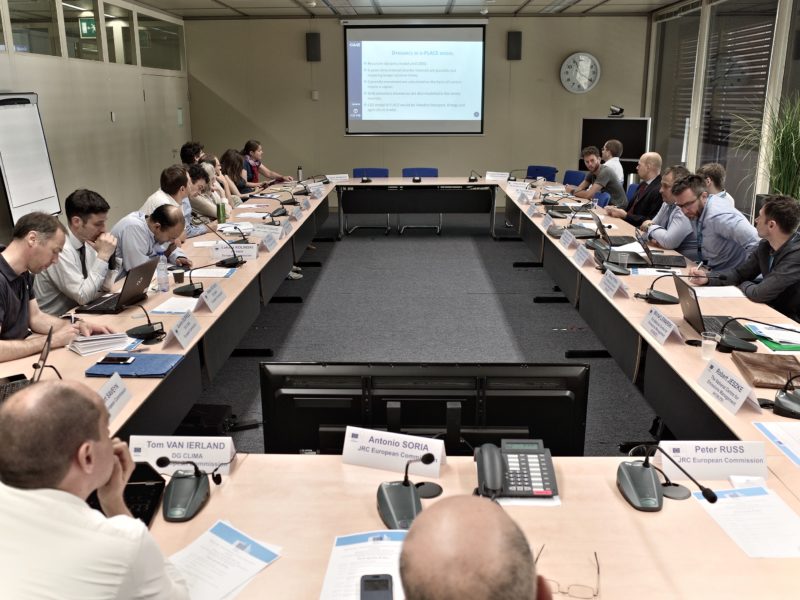
On the 24th of September 2019 a workshop on transport modeling in the context of climate and energy policy challenges took place in KOBiZE.
Robert Jeszke, coordinator of the LIFE Climate CAKE PL project, kicked off the meeting welcoming all invited experts (from i.a. Electric Vehicles Priomotion Foundation (FPPE), Polish Alternative Fuels Association (PSPA), Centre for EU Transport Projects (CEUTP)). Then CAKE experts (Wojciech Rabiega and Jan Gąska) presented the “CO2 reduction potential in the transport sector in Poland and in the European Union”.
Wojciech Rabiega presented the description and features of the CAKE transport model – TR3E (ang. Transport European Economic Model) and presented an analysis of historical sector data. The dynamic partial equilibrium model of the TR3E transport sector is oriented towards a long time horizon (up to 2050 in annual intervals) and covers all transport subsectors (road, rail, air and water) in 28 EU Member States. The model also takes into account the development of new vehicles and technologies (through low-emission vehicles) and uses technologies based on existing fuels (diesel, gasoline, CNG, LPG, hybrids and electric). The model based on the JRC IDEES database – with data on activity, mileage, capacity or loading, and TRACCS – with data on the costs and prices of new vehicles.
The presented historical data on the transport sector in 2000-2015 indicate an increase in passenger transport activity in Poland and in the EU, with the largest share of road and aviation (very dynamic growth, especially in 2014-2015). In these two sectors (road and aviation) there are the greatest challenge and potential for reducing emissions. When it comes to the distribution of emissions in the transport sector in 2015 – both in Poland and the EU, the greater part of emission came from passenger transport than from freight. The distribution of emissions among owners of passenger cars in Poland looks very interesting – in this case, petrol and LPG fueled cars emitted more than diesel.
The description of some of the preliminary results of the analysis carried out on the TR3E model was presented by the second of CAKE experts – Jan Gąska. Three scenarios were assumed for analysis:
Based on the three above scenarios there were shown (all up to 2050):
Preliminary results of the analysis carried out on the TR3E model indicate that a technically potential reduction of emissions is possible, however, this requires at the same time a dynamic increase in sales of electric vehicles, a reduction in the emission of various means of transport and a reduction in the aviation activity or a significant decrease in the emission of this means of transport. In addition, the scenario of „forced” electromobility requires a very fast increase in the share of electric cars in the sale of new cars, which can be a very difficult task. In this situation, an increase in electricity demand from the transport sector will be significant and will require investment in energy infrastructure, and may also hinder the achievement of emission reductions in this sector. Under current technologies, reducing emissions from heavy duty vehicles (HDV) and aviation is key to the net zero goal in transport in 2050. In the first case, the technology already exists (road “trolleybuses”), but it requires very significant investments in road infrastructure and changes in approach. In the case of aviation, reduction of emissions can be very difficult (the possibility of using so-called zero-emission fuels should be examined in this context ).
During the discussion, issues of assumptions for this type of model analysis were raised, e.g. the problem of modeling ticket prices in air transport, or the average mileage of various types of vehicles. Also discussed were issues related to, i.a. the databases used in the model, the assumptions made regarding the decrease in emissions in road transport, taking into account the costs of road infrastructure, the development of new technologies and services in transport (increasing the role of cars on hydrogen fuel, transport autonomy, vehicle sharing), or the EU’s current transport policy, which tends rather towards not increasing the overall number of cars.
The meeting, apart from presenting the model and preliminary results of the analysis to the stakeholders, significantly expanded the team’s knowledge of transport technologies and problems of various databases. This knowledge will allow to significantly improve the transport model and better adapt the scenario assumptions to the likely development of technologies and policies in the future.

On the 29th of August 2019 a workshop on CGE modeling in the context of climate and energy policy challenges took place in KOBiZE.
Robert Jeszke, coordinator of the LIFE Climate CAKE PL project, kicked off the meeting welcoming all guests. At the beginning he introduced, i.a. the KOBiZE tasks, the origins of CAK / CAKE, the assumptions of the LIFE Climate CAKE PL project and a model tool diagram. Then the assumptions for all models were presented in sequence:
The outocmes of the analysis of the phenomenon of carbon leakage in the context of increasing the EU reduction target prepared under CAKE were presented in the resulting part. The analysis is available in PL and ENG:
 Podsumowanie raportu Ryzyko ucieczki emisji w kontekście zwiększenia celu redukcji emisji gazów cieplarnianych UE (849.6 KiB, 2,255 hits)
Podsumowanie raportu Ryzyko ucieczki emisji w kontekście zwiększenia celu redukcji emisji gazów cieplarnianych UE (849.6 KiB, 2,255 hits)
 The risk of Carbon Leakage in the context of increasing the EU Greenhouse Gas Emission reduction taget (3.2 MiB, 2,628 hits)
The risk of Carbon Leakage in the context of increasing the EU Greenhouse Gas Emission reduction taget (3.2 MiB, 2,628 hits)
In the context of this type of analysis, it should be borne in mind that the most important conclusions are of a systemic nature, showing causal links and the mechanisms behind them – emphasized Robert Jeszke. The conducted analysis indicates a problem that may occur if the rest of the world would not undertake appropriate reduction measures when the EU climate policy is tightened. Paradoxically, this can lead as analyzes shows to a negative effect by not only a decrease in the competitiveness of the EU industry, but also, even increase in global emissions. It should be emphasized that the degree of risk of carbon leakage, understood as the transfer of high-emission production, can most affect these EU Member States whose energy mix is based on fossil fuels (including Poland) and energy-intensive sectors of the economy, i.e. the steel, mineral sectors, chemical. Therefore, an important conclusions from the CAKE analysis include i.a. the need for the EU to ensure the implementation of the obligations of other countries (signatories to the Paris Agreement), support for the transfer of low-carbon technologies outside the EU, the possibility of introduction of border carbon tax and support for energy-intensive sectors in the EU. Such actions are key in order to prevent the risk of carbon leakage.
The presentation of preliminary results of the analysis of the energy mix of the EU and individual countries in the 2050 perspective made using the energy model aroused great interest of the gathered guests. Michał Lewarski discussed four scenarios at EU level:
* Emission reduction levels compared to 2015.
The long-term analyzes of the energy sector are of great importance from the point of view of upcoming decisions on setting emission reduction targets at the EU level in the 2050 perspective and their impact on the future shape of the energy mix of individual countries, and thus the costs for their economies. The obtained results show how significant changes in the EU energy sector will have to take place in order to achieve climate neutrality.
The most important element of the workshop from the project’s point of view was the discussion and observations that the guests – experts in modeling and energy and climate policy – had to the results of work carried out under the LIFE Climate CAKE PL project. Interesting suggestions for the development of CAKE tool-kit i.a. the possibility of taking into account the increase in electricity demand in industry, new energy storage technologies, the financial market and its instruments (taxes, customs) were received. Another important conclusion of the meeting was also the indication of the need to ensure that the work performed by analysts and modelersdio would not be put away in a “drawers”, but it would constitute an element in the decision-making process at the political level.
The meeting gave an opportunity to provide an information on the progress of the LIFE project implementation and workshop activities, conferences, meetings, etc.

We are pleased to present the results of the first analysis prepared within the LIFE Climate CAKE PL project, based on d-PLACE model titled “The Risk of carbon leakage in the context of increasing the EU greenhouse gas emission reduction target”. The publication consist of two documents – Full report in English language and Summary which is available in polish language.
The purpose of publication was to assess the possible scale of the carbon leakage using various assumptions and policy scenarios, including the impact on emission levels, GDP and the functioning of economic sectors.
Based on the results of the analysis it should be concluded that carbon leakeage may limit the effectivness of EU climate and energy policy implementation and thus affect the overall volumes of emissions as well as affect the functioning of the economy, industry and the level of well- being in countries with tight reduction targets. Based on the results of the analysis, it can be concluded that the carbon leakeage outside the EU should be seen as an important problem that may affect EU Member States whose energy mix is based on fossil fuels (including Poland) and energy-intensive sectors, i.e. the steel, mineral and chemical sectors.
According to the analysis:
Preliminary results of the analysis were presented among others during COP24 in Katowice and at the meeting of the Steering Committee in December 2018 and this year at the Joint Research Center (JRC) workshop in May in Seville as well as at the GTAP conference in June 2019 (22nd Annual Conference on Global Economic Analysis, University of Warsaw Warsaw, Challenges to Global, Social, and Economic Growth in Warsaw).
 The risk of Carbon Leakage in the context of increasing the EU Greenhouse Gas Emission reduction taget (3.2 MiB, 2,628 hits)
The risk of Carbon Leakage in the context of increasing the EU Greenhouse Gas Emission reduction taget (3.2 MiB, 2,628 hits)
 Podsumowanie raportu Ryzyko ucieczki emisji w kontekście zwiększenia celu redukcji emisji gazów cieplarnianych UE (849.6 KiB, 2,255 hits)
Podsumowanie raportu Ryzyko ucieczki emisji w kontekście zwiększenia celu redukcji emisji gazów cieplarnianych UE (849.6 KiB, 2,255 hits)

On the 28th – 29th of May 2019 in Seville as a part of the implementation of LIFE Climate CAKE PL project a bilateral expert workshop on modelling between CAKE (Center for Climate and Policy Analysis) and the European Commission represented by the Directorate-General for Climate Action (DG CLIMA), Directorate-General for Energy (DG ENER) and the Joint Research Center (JRC – Joint Research Center) took place. About 20 modelling experts in energy and climate policy, as well as in transport and adaptation attended the meeting.
The meeting was organized in order to:
Experts from LIFE Climate CAKE PL and Joint Research Center emphasized that analytical tools which are being developed significantly contribute to the dissemination of knowledge about the neces
sity of the reduction of greenhouse gas emissions and the need to undertake necessary actions on climate protection in the perspective up to 2050.
Moreover the workshop gave an opportunity to present model assumptions and model tools developed as a part of LIFE Climate CAKE PL.
During the meeting, the important role of modelling results in the decision-making process by the administration were underlined and experiences of accessible forms of presenting model results were discussed. LIFE Climate CAKE PL experts presented the CGE d-PLACE model, the MESSA energy model and the TR3E transport sector model. In addition, preliminary results of the analysis concerning the effects of carbon leakage performed with d-PLACE model were showed. Carbon leakage is the result of the diversification of climate policy actions carried out in different parts of the world what can affect the competitive position of various EU industries. The analysis made by CAKE experts was aimed to shown the possible scale of carbon leakage, with the assumption of different GHG emission reduction scenarios in the EU and identification of carbon leakeage channels which could allow for more effective prevention of this phenomenon in the future.
Experts from Joint Research Center discussed some of the developed tools e.g.,:POTEnCIA, PIRAMID, T-NET model, as well as the model for evaluation of the impact of climate change on Peseta’s economy. Moreover, the Integrated Database of the European Energy Sector (IDEES) that is used, among others, in the POTEnCIA model at Joint Research Centre (JRC) were presented. It is worth to be noted that the IDEES database is also used in the transport model in the LIFE Climate CAKE PL project and in the future it may become an important source of historical data for other models.
It should be emphasized that the exchange of knowledge and experiences between the Center for Climate and Policy Analysis (CAKE) and representatives of Joint Research Centre (JRC) provided an opportunity to get to know broader perspective of the ongoing works as well as current and future analytical challenges in the area of climate protection. Furthermore, experts of the LIFE CAKE PL team have particularly benefited from the experiences of JRC by familiarizing with the technical details of the tools, which would allow to improve the quality of created models. This acquired knowledge will be used in the further work of the LIFE Climate CAKE PL team in the CGE, transport and energy models.
On the 9th of May 2019 in Serock we took part in an event „Cities and municipalities as leaders in climate and energy activities” organised by Stowarzyszenie Gmin Polska Sieć „Energie Cités” where the latest initiatives (Covenant of Mayors for Climate and Energy), funding opportunities (NFOŚiGW) and examples of implementations of green solutions in cities (Bydgoszcz, Warsaw, 44MPA project) were presented. During the table session, we presented the scope of LIFE Climate CAKE PL and discussed needs of local administration in case of project deliverables.